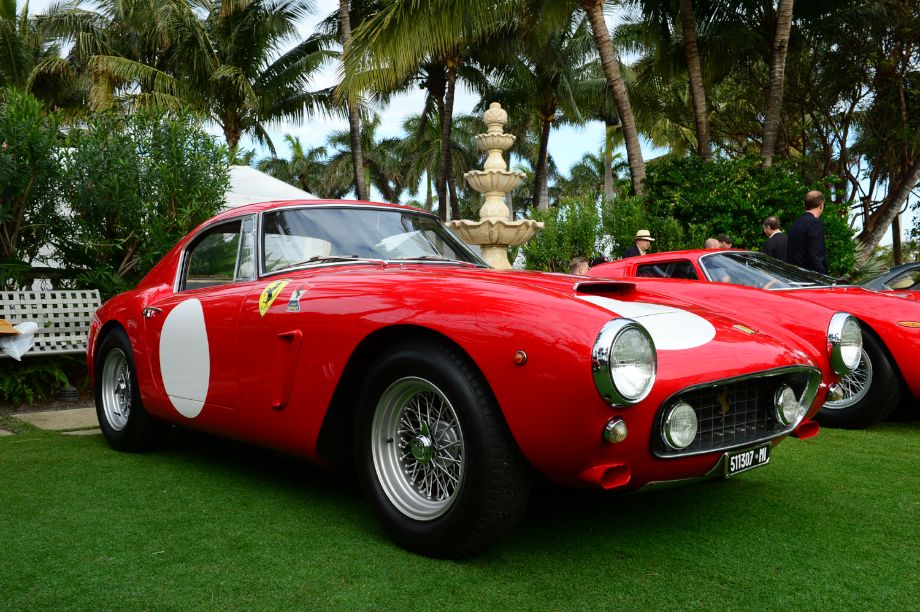1960 Ferrari 250 GT SWB Berlinetta Competition

The descriptions of the Classic Cars in the Directory were partly generated or supplemented with the help of artificial intelligence (AI). The content may occasionally not always be entirely accurate or factually correct despite careful checking.
The Ferrari 250 GT SWB Berlinetta Competition 1960 is a race-ready masterpiece that is one of the most sought-after Ferrari models of all time. Its technical specifications and performance alone have earned it a place in the annals of automotive history.
Firstly, the car features a 3.0-liter Tipo 168/61 Colombo V12 engine with a six-carburetor setup, generating a thunderous 280 horsepower and 213 pound-feet of torque. It also comes equipped with a four-speed manual gearbox that offers rapid gear changes and outstanding gear ratios. The suspension system is comprised of independent front and rear suspension featuring coil springs, telescopic dampers, and an anti-roll bar.
The car's exteriors are also carefully crafted to provide both superior aerodynamics and an aesthetically pleasing design. It boasts a sleek and aggressive body that blends style with function. The nose of this machine features a large rectangular grille, flanked by circular headlights, and covered in louvers to funnel air to the brakes.
The interior of the Ferrari 250 GT SWB Berlinetta Competition 1960 is equally impressive. Its bucket seats are upholstered in high-quality leather, offering both comfort and support. The dash is an instrument cluster of white-faced gauges, featuring a large tachometer front and center, and comprehensive auxiliary instrumentation. The interior is perfectly designed for racing, with a flat-bottomed steering wheel, a short shift lever, and pedals that are strategically positioned for the best driving experience.
Additionally, the Competition version of the vehicle is equipped with an even more robust engine, exhaust system and air intakes, making it a highly sought after version amongst collectors. It also features less weight and an altered rear end, bringing the weight balance of the vehicle towards the center for better performance.
It's no wonder that the Ferrari 250 GT SWB Berlinetta Competition 1960 is considered one of the most iconic and valuable automobiles in the world. With a top speed of around 160 miles per hour, high performance capabilities, exceptional handling, and lasting aesthetics, it has certainly earned its place in automotive history.
Milestones
- The Ferrari 250 GT SWB Berlinetta Competition was developed as a racing version of the standard 250 GT SWB model. - It was first introduced in 1959 and continued to be produced till 1962. - The car was powered by a 3.0-liter V12 engine that produced 280 horsepower, making it one of the most powerful racing cars of its time. - The car's lightweight body and high-performance suspension system made it highly agile on the track, making it a favorite among racing enthusiasts. - In 1960, a Ferrari 250 GT SWB Berlinetta Competition driven by Stirling Moss and Dan Gurney won the 12 Hours of Sebring. - That same year, another 250 GT SWB Berlinetta Competition won the Tour de France Automobile. - The car's success on the racing circuit led to the development of various versions, including the 250 GT SWB California Spyder and the 250 GT SWB Competizione. - Today, the Ferrari 250 GT SWB Berlinetta Competition is considered one of the most iconic Ferrari models ever built and is highly sought after by collectors and enthusiasts around the world.Technical
- Engine: 3.0-liter Colombo V12 - Power: 280 horsepower at 7,200 rpm - Torque: 221 lb-ft at 5,500 rpm - Transmission: 4-speed manual - Suspension: Independent front and rear with coil springs - Brakes: Disc brakes on all four wheels - Body: Lightweight aluminum alloy construction with Kammback tail - Wheelbase: 2,400 mm (94.5 in) - Length: 4,200 mm (165.4 in) - Weight: Approximately 1,000 kg (2,205 lbs) - Top speed: 280 km/h (174 mph) - 0-60 mph acceleration time: Approximately 6.5 seconds - Production: Approximately 42 competition models produced from 1960 to 1962.